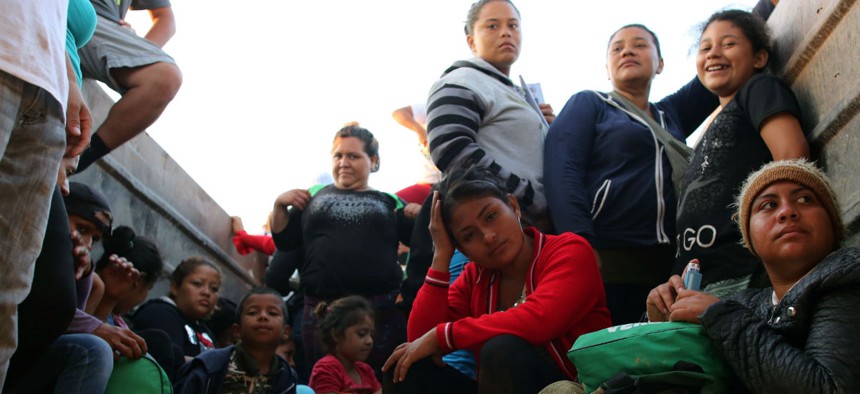
Honduran women and children fleeing poverty and gang violence in a caravan to the United States in November 2018 sit in a dump truck taking them to their next stop in Oaxaca, Mexico. Vic Hinterlang / Shutterstock.com
Viewpoint: America’s Asylum System Is Profoundly Broken
Until the United States establishes and articulates clear rules, the crisis at the border will continue.
A 25-year-old man from El Salvador tried to swim with his daughter across the Rio Grande to Brownsville, Texas. Father and daughter were caught in the current, and drowned. Their bodies washed ashore on the Mexican side of the river, in an image that has seized the attention of the world.
But other sights, not photographed, are equally horrifying. A woman from Punjab, India, tried to walk her 6-year-old daughter across the Arizona desert earlier this month. The girl succumbed to heat stroke in the desert. The Border Patrol found the girl’s body.
Hundreds of African migrants have arrived on the U.S. southern border since October of last year. They’ve reported deaths along their route, again of heat and dehydration.
In the single month of May 2019, 133,000 people were apprehended on the southwestern border. Thanks to better cooperation with Mexico, apprehensions fell to 87,000 in June, still higher than at any previous point in the Trump or Obama administrations. It’s possible that more than 1 million people will be apprehended after entering the U.S. without authorization in fiscal 2019, a rate of unauthorized immigration not seen since the 1990s. They are coming from more than two dozen nations, and some from across two great oceans, transiting countries along the way in which they could find refuge, if refuge were all they sought. It is reasonable to wonder whether they believe that America’s door is open—and whether they are risking their lives and those of their children to rush through it before that door closes again.
Migration is not a project for the destitute or desperate. Human smugglers charge $3,500–$7,000 a person to convey a would-be asylum seeker from Central America to the United States. The trip from Africa costs much more. Some Congolese migrants, interviewed by The New York Times, began by traveling overland to Angola. From that country, they flew across the Atlantic and South America to Ecuador. Then they continued by bus and foot northward thousands of miles across Colombia, Central America, and Mexico to Texas.
How do they afford the journey? There are as many different answers to that question as there are migrants. Here’s the story of the Punjabi family that lost their daughter in the Arizona desert. The father, known as A. Singh, made his way to the United States in 2013. He filed an asylum petition. This was not a promising plan. In 2013, U.S. courts rejected 97 percent of asylum requests filed by Indian citizens.
But after rejection, there’s appeal. If you lose on appeal, you can just stop showing up. The authorities are unlikely to find you, and even if they do, they are unlikely to send you home. Six years later, A. Singh is still in the United States, his asylum case still unresolved. Along the way, he accumulated enough money to send for his wife and daughter. They traveled from India to Mexico, and were then met by smugglers who led them part of the way along the border—and then abandoned them without water in the scorching June desert heat.
Migrant children usually follow adults who have made the journey ahead of them. Warren Binford, a law professor at Willamette University, visited a Clint, Texas, detention facility earlier this month. In a June 21 PBS interview, Binford told Judy Woodruff, “Almost every child that I interviewed had family, parents, uncles, aunts, grandparents, siblings here in the United States who are waiting for them and are ready to care for them.”
Migration is a networked process. As a migrant diaspora expands, it can accumulate resources to enable more relatives to follow—many of them escaping desperate circumstances, in search of a better future. Those resources include not only the cash necessary to pay the smugglers, but also the sophisticated local understanding that enables asylum seekers to settle more easily. It’s tough to be the first Congolese asylum seeker to arrive in Portland, Maine (the city in which 300 Congolese asylum seekers have recently arrived). It will be easier to be the 300th, and it will be easier than that to be the 3,000th. Their predecessors will help them find places to live and work, and show them how to navigate the bureaucracy that will process their cases.
This network effect may help explain a paradox that would seem otherwise mystifying: Why is migration from Central America surging even as the crimes that supposedly motivate the migration are plunging?
The homicide rate in Honduras dropped by more than a third from its peak, in 2011, to 2016. The homicide rate in Guatemala dropped by nearly half from the peak year, 2009, to 2016. Yet only after 2014 did Central American asylum seekers begin arriving in large numbers.
One answer may be the network effect. The years of peak violence in Central America were a weak period for the U.S. job market. As the U.S. economy improved after 2014, migration from Central America accelerated. And as the numbers of recent Central American migrants grew, so did the resources available to finance the migration of even more. Migration builds on itself. So long as American and European wages greatly exceed those in large portions of the rest of the world, the number of would-be migrants will continue to rise.
Some read the stories published in 2017 about how illegal immigration was reaching its lowest levels in 46 years, and concluded it had come to an end. What happened instead was that the flow of migrants to the U.S. shifted from adults simply crossing the border on an entirely illegal basis, to migrants—increasing numbers of children among them—making claims of asylum.
Over the past 14 years, the United States has made itself less congenial to immigrants without any legal status at all. The Real ID Act, passed by Congress in 2005, has inhibited the ability of unauthorized residents to obtain plausible-looking fake documents. The spread of the E-Verify system is likewise discouraging to the immigrants who have no legal basis at all for their presence in the United States.
Asylum seekers, by contrast, are allowed to work pending resolution of their cases. In most states, they will be allowed to apply for a driver’s license that complies with the Real ID law. This is one reason why some asylum applicants seek to remain within the asylum system as long as they can. So long as their applications are pending, or under appeal, they benefit from a legal immigration status inside the United States. And because the asylum system is so incredibly slow, who knows how long that status might last?
It may be that those with the very weakest claims drop out at the start of the process. Half of those admitted to the U.S. as asylum seekers never actually filea legal asylum application. The other half, however, find their best opportunity to be the provisional legality offered by the asylum process.
The Trump administration has sought to stop this process before it even starts by preventing migrants from entering the United States in the first place.
Óscar and Valeria Ramirez—the father and daughter who died in the Rio Grande—had waited for days to cross a bridge at Matamoros and reach the U.S. to file a claim. Frustration with the long delay pushed Ramirez to his fatal decision to swim across.
The detention of asylum seekers is also intended as a deterrent, but it has not proved very effective. Congress has funded only 45,000 detention beds, declining to 40,000 after September of this year. And since a 1997 judicial settlement forbids immigration authorities to detain adults and unaccompanied minors together, the detention policy in turn has given rise to the inhumane system of separate facilities for minors.
Nobody intended to build “concentration camps,” as they have been polemically denounced. What we’re seeing instead is the inevitable failure of the attempt to process hundreds of thousands of would-be migrants through a system intended for a few thousand victims of state-sponsored persecution—all under the supervision of a slow-moving judiciary and subject to tight budget constraints. Of course it’s a miserable failure. And of course the people responsible for administering that inevitable failure become short-tempered, harsh, and secretive. They are bureaucrats tasked to do the predictably impossible.
How can we make things better?
We have to stop enticing a million people a year to risk their lives and their children’s lives by gaming the U.S. asylum system.
The response of many people of goodwill—open the gates, let the asylum seekers in—will bump into the reality of millions more who will want to come. The more allowed in, the more who will gamble on forcing their way in after them, the more lives will be lost as they make their way toward the United States.
The asylum system is profoundly broken, and the only way to make it work is to begin with fundamental questions. If poverty, unemployment, crime, spousal abuse, and other non-state-imposed forms of human suffering justify an asylum claim, then at least 2 billion people on Earth are eligible if they can make it over the border.
If every asylum claim must be adjudicated by a quasi-judicial tribunal, then appealed, then enforced only after another quasi-judicial tribunal and another appeal, then the asylum system becomes an invitation for abuse, joined to a full-employment scheme for immigration lawyers.
Unlike asylum seekers, refugees who seek entry into the United States are managed through an entirely executive process. The U.S. decides on the number of refugees it will take and from which countries, and deputes selection of individuals to the Department of State. The system isn’t perfect, but it’s fast and efficient compared with the shambles of asylum.
Perhaps even more important: The refugee system is based on truth. Refugees have been displaced from their home countries. The asylum system, by contrast, is built on the idea that most of the asylum seekers moving to the U.S. from Central Africa, South Asia, and Central America cannot halt at any of the other countries on their multi-thousand-mile land-air-land routes to Texas and Arizona, and claim asylum there instead.
This is not 1939. Virtually none of those trying to cross the Rio Grande are fleeing state-sponsored persecution, although many do face real hardship at home. Many are people living in a globalized world willing to brave big risks with their lives and money in hope of bettering their situation. Almost all of us in the United States are descended from people like that, so of course we sympathize. But the policies that made sense for the United States in 1890 do not make sense in 2020.
There’s room for some, but not for all who want to come. Awarding the prize to those who show up on the American doorstep only encourages the abuses of the people-smugglers.The more clearly the U.S. articulates its rules, and the more swiftly and certainly it enforces those rules, the more lives will be saved. Those who seek to change the rules by acquiescing in fictions about asylum are worsening the border crisis, inviting more deadly risk taking by migrants—and igniting more cynicism in this country about the accountability of the U.S. government to its own people.
We want to hear what you think about this article. Submit a letter to the editor or write to letters@theatlantic.com.
Image via Vic Hinterlang / Shutterstock.com.







